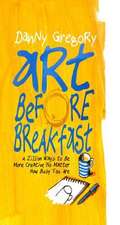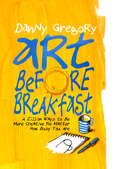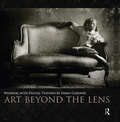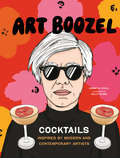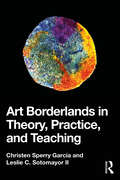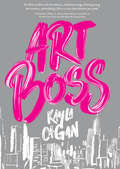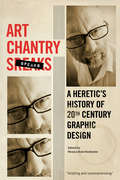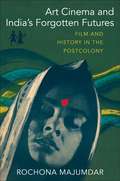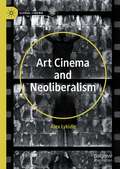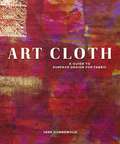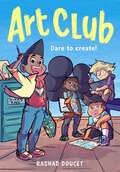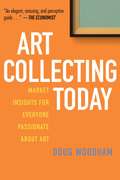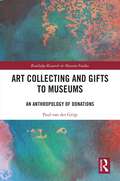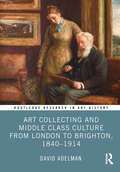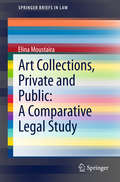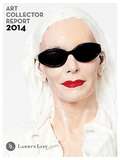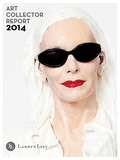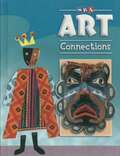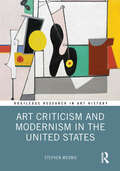- Table View
- List View
Art Before Breakfast
by Danny GregoryPacked with the signature can-do attitude that makes beloved artist Danny Gregory a creativity guru to thousands across the globe, this unique guide serves up a hearty helping of inspiration. For aspiring artists who want to draw and paint but just can't seem to find time in the day, Gregory offers 5- to 10-minute exercises for every skill level that fit into any schedule--whether on a plane, in a meeting, or at the breakfast table--along with practical instruction on techniques and materials, plus strategies for making work that's exciting, unintimidating, and fulfilling. Filled with Gregory's encouraging words and motivating illustrations, Art Before Breakfast teaches readers how to develop a creative habit and lead a richer life through making art.
Art Before Breakfast: A Zillion Ways to be More Creative No Matter How Busy You Are
by Danny GregoryPacked with the signature can-do attitude that makes beloved artist Danny Gregory a creativity guru to thousands across the globe, this unique guide serves up a hearty helping of inspiration. For aspiring artists who want to draw and paint but just can't seem to find time in the day, Gregory offers 5– to 10–minute exercises for every skill level that fit into any schedule—whether on a plane, in a meeting, or at the breakfast table—along with practical instruction on techniques and materials, plus strategies for making work that's exciting, unintimidating, and fulfilling. Filled with Gregory's encouraging words and motivating illustrations, Art Before Breakfast teaches readers how to develop a creative habit and lead a richer life through making art.
Art Beyond The West
by Michael Kampen-O'RileyIn this major survey of the arts of Africa, Western and Central Asia, India, Southeast Asia, China, Korea, Japan, the Pacific, and the Americas, author Michael Kampen-O’Riley presents the vast range of arts that lie outside of the Western tradition. Within a predominantly geographic and chronological framework, he explores the arts of these areas from pre-history to present day. The first dedicated survey of “non-Western” art, Art Beyond the West is amply illustrated and accessibly written.
Art Beyond the Lens: Working with Digital Textures
by Sarah GardnerVintage-looking, dream-like textures can open up a whole new world in your photography. However, there is much, much more to working with textures than simply merging them with an image via Photoshop. In this gorgeous new guide from texture guru Sarah Gardner, you'll learn everything there is to know about how to maximize the potential of these exciting tools. In addition to hundreds of beautiful example images, this book is also packed with practical advice on what makes a good texture, and how and when to use them. How an image is initially captured and processed has a significant impact on the effect a texture will have, so you'll also learn what to consider when composing and shooting (rather than simply relying on post-processing) and how to use lighting and background considerations effectively for later work with textures. Workshop notes and a supplemental website will help you put Sarah's techniques into practice immediately. Beautiful enough to sit on your coffee table yet practical enough to store near your computer, this book will show you everything you need to know to get that coveted vintage-feel in your images, whether you're a casual family snapper or a seasoned professional.
Art Boozel: Cocktails Inspired by Modern and Contemporary Artists
by Jennifer CrollRaise a glass to the world's most exciting modern and contemporary artists in this inspired cocktail book with over 50 tribute recipes.Go on a boozy tour of art history with this collection of recipes for over 50 expertly crafted cocktails, each one a unique creation inspired by its namesake artist. Unwind with a refreshing tequila-watermelon Frida Kahlo. Spark some inspiration while sipping on a Salvador Dalí. Or mix it up with a colorfully sweet Yayoi Kusama.From painters to sculptors, photographers, and more, each artist profiled has a cocktail recipe that draws deeply from their life and work. Both art lovers and cocktail enthusiasts alike will love pouring over this collection of engaging stories and unique recipes. Inventive and deliciously fun, ART BOOZEL will give you a new appreciation for each of these inspiring artists.INVENTIVE & FUN RECIPES: Each of these recipes draws from elements of the artist's life and work in colorful ways that any cocktail enthusiast will enjoy; think tomato garnishes in the Andy Warhol, golden turmeric in the Gustav Klimt, and flower syrup in the Georgia O'Keeffe.BESTSELLING TEAM: Jennifer Croll and Kelly Shami, the author and illustrator who brought you the wildly popular FREE THE TIPPLE, are back to deliver more of the colorful cocktail recipes and lush illustration that everyone loves.PERFECT FOR ART LOVERS: Any level of art appreciator will enjoy pouring over the diverse biographies and engaging portraits, and will love creating drinks inspired by their favorite modern and contemporary artists.Perfect for: mixology enthusiasts; art and art history lovers; museum and gallery visitors, especially visitors to SFMOMA, MoMA, and LACMA; readers of Punch, Bon Appétit, Saveur.
Art Borderlands in Theory, Practice, and Teaching
by Christen Sperry García Leslie C. Sotomayor IIResponding to an absence of Latine and Chicane artist and teaching resources, Art Borderlands in Theory, Practice, and Teaching shows how artists and educators can use borderlands, in-between geographical, emotional, cultural, and conceptual spaces, in three ways: theory, art practice, and teaching.Throughout this teaching-oriented text, the authors draw from borderlands theories and apply them to visual art and teaching. This volume centers art making and teaching practices based on borderlands lived experiences that are not commonly taught in higher education. Making productive the rupture and fragmentation that occurs in borderlands spaces, this text explores ways in which artists rebuild and become whole again through the process of making art. Using hands-on approaches, the authors model how to use borderlands theories in the classroom by employing arts-based and teaching methodologies. This includes access to Latine and Chicane centered digital information, interactive classroom activities, artist resources, and beyond the classroom learning experiences.Art Borderlands in Theory, Practice, and Teaching offers artists, students, and educators art making and teaching approaches that are centered on Latine and Chicane theories and concepts.
Art Boss
by Kayla CaganArtist Piper Perish has moved from her hometown of Houston, Texas, to New York City. Her days are spent exploring; her nights are filled with painting. It's her lifelong dream come true . . . . Except life in the city isn't as glamorous as it looks from afar. Piper's high-pressure work as an assistant to a famous modern artist takes away time from her own art. And Piper's new friend Grace, a budding activist, has Piper beginning to wonder if making great art is really enough.In a story that stands alone but can be read as a companion novel to Piper Perish, acclaimed author Kayla Cagan returns with Piper's powerful and utterly authentic journey of growing up into a strong, independent young woman—as she learns how to make life about art, and how to make that art matter. Art Boss will have readers asking big questions along with Piper. What is art for? What can art do? And how can a young artist change the world?
Art Chantry Speaks
by Art Chantry Monica René RochesterThere used to be a time when designers were trained in the history of composition. Now you just buy a fuckin' piece of software and now you've become a designer."Art Chantry . . . Is he a Luddite?" asks a Rhode Island School of Design poster promoting a Chantry lecture. "Or is he a graphic design hero?"For decades this avatar of low-tech design has fought against the cheap and easy use of digital software. Chantry's homage to expired technology, and his inspired use of Xerox machines and X-Acto blade cuts of printed material, created a much-copied style during the grunge period and beyond.Chantry's designs were published in Some People Can't Surf: The Graphic Design of Art Chantry (Chronicle Books), exhibited at the Seattle Art Museum, the Rock and Roll Hall of Fame, the Museum of Modern Art, the Smithsonian, and the Louvre.More recently, Chantry has drawn upon his extraordinary collection of twentieth-century graphic art to create compelling histories of the forgotten and unknown on essays he has posted on his Facebook page. These essays might lionize the unrecognized illustrators of screws, wrenches, and pipes in equipment catalogs. Other posts might reveal how some famous artists were improperly recognized.Art Chantry Speaks is the kind of opinionated art history you've always wanted to read but were never assigned.
Art Cinema and India’s Forgotten Futures: Film and History in the Postcolony
by Rochona MajumdarThe project of Indian art cinema began in the years following independence in 1947, at once evoking the global reach of the term “art film” and speaking to the aspirations of the new nation-state. In this pioneering book, Rochona Majumdar examines key works of Indian art cinema to demonstrate how film emerged as a mode of doing history and that, in so doing, it anticipated some of the most influential insights of postcolonial thought.Majumdar details how filmmakers as well as a host of film societies and publications sought to foster a new cinematic culture for the new nation, fueled by enthusiasm for a future of progress and development. Good films would help make good citizens: art cinema would not only earn global prestige but also shape discerning individuals capable of exercising aesthetic and political judgment. During the 1960s, however, Satyajit Ray, Mrinal Sen, and Ritwik Ghatak—the leading figures of Indian art cinema—became disillusioned with the belief that film was integral to national development. Instead, Majumdar contends, their works captured the unresolvable contradictions of the postcolonial present, which pointed toward possible, yet unrealized futures.Analyzing the films of Ray, Sen, and Ghatak, and working through previously unexplored archives of film society publications, Majumdar offers a radical reinterpretation of Indian film history. Art Cinema and India’s Forgotten Futures offers sweeping new insights into film’s relationship with the postcolonial condition and its role in decolonial imaginations of the future.
Art Cinema and Neoliberalism (Global Cinema)
by Alex LykidisArt Cinema and Neoliberalism surveys cinematic responses to neoliberalism across four continents. One of the first in-depth studies of its kind, this book provides an imaginative reassessment of art cinema in the new millennium by showing how the exigencies of contemporary capitalism are exerting pressure on art cinema conventions. Through a careful examination of neoliberal thought and practice, the book explores the wide-ranging effects of neoliberalism on various sectors of society and on the evolution of film language. Alex Lykidis evaluates the relevance of art cinema style to explanations of the neoliberal order and uses a case study approach to analyze the films of acclaimed directors such as Asghar Farhadi, Yorgos Lanthimos, and Lucrecia Martel in relation to the social, political, and cultural characteristics of neoliberalism. By connecting the aesthetics of art cinema to current social antagonisms, Lykidis positions class as a central concern in our understanding of the polarized dynamics of late capitalism and the escalating provocations of today’s film auteurs.
Art Cities Of The Future: 21st-Century Avant-Gardes
by Reid Shier Antawan I. Byrd Geeta Kapur Kaelen Wilson-GoldieIn the 1990s a quiet revolution began. Contemporary art, for decades an enterprise dominated by a relatively small number of individuals - artists, dealers, collectors, curators and critics based in three or four cities - gradually became global. Biennials sprang up in every corner of the world just as cheap airfares began to shrink the distances between them. Emerging technologies opened up new lines of communication, and international publishers launched contemporary art lists. Meanwhile art fairs grew and multiplied, creating a movable feast with regular stops on every continent. Today the art world is more of a world in every sense, with a larger population, a wider territory and a greater number of nationalities. Its prevailing conversation, however, has yet to catch up. This conversation, still shaped by the belief that artistic progress stems from the avant-garde - a cohesive group with a common lineage, all grappling with a shared set of artistic issues - risks overlooking the real breakthroughs taking place all around us. Art Cities of the Future uncovers twelve distinct avant-gardes that have emerged around the world in recent decades. Twelve curators each select eight artists to represent the avant-garde of a specific city. These artists may be senior figures or newer faces, artists working in familiar mediums or inventing their own, but they all share two qualities- a commitment to experimental art and a dedication to their local milieu. These twelve cities are art's next capitals, and from this batch of 96 artists will emerge tomorrow's stars - the future heroes of art history and the market's next blue-chip investments.
Art Cloth
by Jane DunnewoldThis information-packed handbook is appropriate for both newcomers and experienced dyers but assumes that readers have a serious interest in textile design.
Art Cloth
by Jane DunnewoldThis information-packed handbook is appropriate for both newcomers and experienced dyers but assumes that readers have a serious interest in textile design.
Art Club (A Graphic Novel)
by Rashad DoucetInspired by the author&’s own childhood, this contemporary graphic novel paints a picture of an aspiring young artist on a mission to prove that the arts are worth fighting for. Dale Donavan has heard the same lecture over and over again: Art will get you nowhere in life. A kid with a creative streak, Dale wants nothing more than to doodle, play video games, and create comics forever—maybe even as a full-time job one day. But between his grandfather pushing him to focus on his studies and a school with zero interest in funding arts programs, Dale feels like his future has already been decided for him. That is, until he comes up with the perfect plan: What if he starts an after-school art club, gathers a team of creative students like himself, and proves all the naysayers—his stubborn vice principal in particular—wrong? This might just work, but if the club isn&’t financially successful by the end of the semester, the school with shut them down. This may be Dale&’s only chance to show the adults in his life that a career as an artist is not just a dream but a possibility!
Art Collecting Today: Market Insights for Everyone Passionate about Art
by Doug WoodhamAn insider's guide to buying, collecting, and selling art from an insider of Christie's Grounded in real-life stories, Art Collecting Today is the essential practical guide to today's art market. A lightly regulated industry with more than sixty billion dollars of annual sales, the art market is often opaque and confusing to even the most experienced collectors. But whether a seasoned collector, an uninitiated newcomer, or an art-world insider, readers will learn within these pages how the art marketplace works in practice and how to navigate it smartly. Those who may have been put off by art-world practices will finally feel they have the knowledge needed to participate freely and fully, and collectors will be able to pursue their passion with more confidence. Important topics covered include:How to evaluate, buy, and sell art while avoiding costly mistakes and time-consuming roadblocks How the market works in practice for essential artists like Ren? Magritte, Christopher Wool, Amedeo Modigliani, and Yayoi Kusama How collectors can be taken advantage of, and the actions they should take to protect themselves Why tax laws in the United States reward "art investors" yet penalize "art collectors" How cultural property laws impact the market for works by such artists as Frida Kahlo and Andy Warhol Advice for new and prospective collectors Informed by close to one hundred interviews with collectors, lawyers, art advisors, gallerists, and auction specialists in the United States and Europe, as well as by the author's own experiences, Art Collecting Today offers a lively and thought-provoking analysis of the day-to-day workings at play today in the fine art marketplace.
Art Collecting and Gifts to Museums: An Anthropology of Donations (Routledge Research in Museum Studies)
by Paul van der GrijpArt Collecting and Gifts to Museums questions why private collectors donate their collection, or parts of it, to museums and examines what the implications of this gifting process might be.Presenting case studies from Europe, North America, East Asia, and the South Pacific, this book is concerned with both elite and popular collections and examines the act of donating art from the collector’s point of view. Demonstrating that art museums depend on donations from private collectors, Paul van der Grijp emphasizes that it is crucial to understand the psychological, sociological, economic, and educational motivations for gifting works of art to institutions. Taken together, the chapters argue that collectors donate to museums because the latter represent an imagined community, to whom those collectors would like to bestow a sacred gift. Private collectors are, Van der Grijp maintains, motivated to ensure the immortality of their collections and, ultimately, to preserve some memory of their own lives in the process.Art Collecting and Gifts to Museums will be of interest to researchers and students engaged in the study of museums, culture, art, anthropology, history, and sociology.
Art Collecting and Middle Class Culture from London to Brighton, 1840–1914 (Routledge Research in Art History)
by David AdelmanThis study explores the interplay between money, status, politics and art collecting in the public and private lives of members of the wealthy trading classes in Brighton during the period 1840–1914.Chapters focus on the collecting practices of five rich and upwardly mobile Victorians: William Coningham (1815–84), Henry Hill (1813–82), Henry Willett (1823–1905) and Harriet Trist (1816–96) and her husband John Hamilton Trist (1812–91). The book examines the relationship between the wealth of these would-be members of the Brighton bourgeoisie and the social and political meanings of their art collections paid for out of fortunes made from sugar, tailoring, beer and wine. It explores their luxury lifestyles and civic activities including the making of Brighton museum and art gallery, which reflected a paradoxical mix of patrician and liberal views, of aristocratic aspiration and radical rhetoric. It also highlights the centrality of the London art world to their collecting facilitated by the opening of the London to Brighton railway line in 1841.The book will be of interest to scholars working in art history, museum studies and British history.
Art Collections, Private and Public: A Comparative Legal Study (SpringerBriefs in Law)
by Elina MoustairaThis book is a comparative legal study of the private and public art collections in various states of the world, covering the most important issues that usually arise and focusing on the differences and the similarities of the national laws in the treatment of those issues.
Art Collector Report
by Larry'S ListThe Larry's List team consists of art market researchers from around the world. Currently, we have more than 20 nationalities, each researcher with a background in art history or experience with art dealing.Which city in the world has the highest density of 2014 contemporary art collectors? Which country?Why does Germany almost have as many private art museums as the us?And what are the future trends for the global collectors scene?What you get: Unique Information on Art Collectors! The report offers detailed information on leading art collectors around the world. Our researchers carefully selected the data manually.
Art Collector Report KINDLE EDITION
by Larry'S ListThe Larry's List team consists of art market researchers from around the world. Currently, we have more than 20 nationalities, each researcher with a background in art history or experience with art dealing.<P><P>Which city in the world has the highest density of 2014 contemporary art collectors? Which country?Why does Germany almost have as many private art museums as the us?And what are the future trends for the global collectors scene?What you get: Unique Information on Art Collectors! The report offers detailed information on leading art collectors around the world. Our researchers carefully selected the data manually.
Art Connections (Level #2)
by McGraw-HillArtists make art about many subjects. Subject matter is the content of an artist's work. For example, the subject of a painting can be a vase of flowers or a self-portrait. This subject matter is easy to see. The subject matter is harder to understand when the artwork stands for something beyond itself.
Art Connections (Level #6)
by McGraw-HillThis textbook is about art, its history and culture, aesthetic perception, art criticism, etc.
Art Criticism and Modernism in the United States (Routledge Research in Art History)
by Stephen MoonieThis study is an analysis of 'high' and 'late' modernist criticism in New York during the 1960s and early 1970s. Through a close reading of a selection of key critics of the period—which will expand the remit beyond the canonical texts—the book examines the ways that modernist criticism’s discourse remains of especial disciplinary interest. Despite its alleged narrowness and exclusion, the debates of the 1960s raised fundamental questions concerning the nature of art writing. Those include arguments around the nature of value and judgement; the relationship between art criticism and art history; and the related problem of what we mean by the ‘contemporary.’ Stephen Moonie argues that within those often-fractious debates, there exists a shared discourse. And further, contrary to the current consensus that modernists were elitist, dogmatic, and irrelevant to contemporary debates on art, the study shows that there is much that we can learn from reconsidering their writings. The book will be of interest to scholars working in art history, modern art, art criticism, and literary studies.
Art Deco
by Eric KnowlesAlthough most associated with the 1920s and 30s, Art Deco began in France prior to World War I. During the interwar years the style evolved and was adopted by an international elite set as the perfect expression of modern opulence and elegance in an age that gave birth to jazz, the Charleston, speakeasies, glamorous Hollywood films and engineering marvels such as skyscrapers. At the height of its popularity the Art Deco influence was seen in a wide variety of remarkable and innovative applications from decorative arts such as jewelry, metalwork, ceramics, and glass to massive scale applications in architecture, interior design, fashion, public works projects and consumer goods from automobiles to telephones to jukeboxes. This unique book is a collection of the most beautiful examples of Art Deco style from personal statements in jewelry to skyscrapers that defined city skylines, and examines the social and cultural climates of the 1920s and 30s which were perfectly aligned with the optimism and elegance of Art Deco. It traces the seminal influences in its evolution including the Ballets Russes, Cubism and the Bauhaus and explains why Art Deco style continues to attract new collectors and enthusiasts who connect with this design styles' impeccable ability to convey opulence, elegance, and exclusivity.
